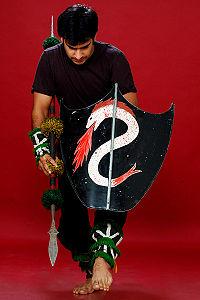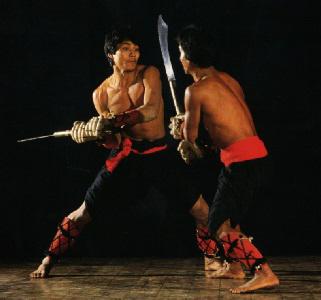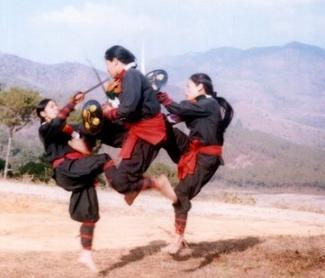 |
Thang-Ta means
"The Art of the Sword and Spear"-- is the traditional martial art of Manipur
in Northeast India.
It integrates various
external weapons - the sword, spear, dagger, etc. - with the internal
practice of physical control through soft movements coordinated with the
rhythms of breathing.
|
 |
|
The proper
name for Thang-Ta is HUYEN LALLONG ("method of safe-guarding"). As the name
implies, Huyen Lallong is more than just the training of fighting skills. It
is an elaborate system of physical culture that involves breathing methods,
meditations, and rituals. Some of the sword and spear forms are entirely
ritualistic, although they are composed of material techniques. They are to
be performed only at special occasions or under special circumstances.
For
example, there is a spear form that is performed at funerals. Perhaps the
most famous form is the ritual spear dance done by King Bhagyachandra (ruled
1759-1798) on a mountain top during his exile due to the Burmese invasion in
1762. The Manipuris believe that the ritual was instrumental in driving the
Burmese out of Manipur. |
 |
|
It is part
of the great heroic tradition of Manipur. Its origin lies in the timeless
creation myths where, according to local legend, all movements of the
Manipuris originated from Thang Ta
The Sword.
There are literally hundreds of different sword drills for training the
basic strokes and stepping patterns. Many are two person sets, but others
may be practiced solo, at least initially. The Thang-Ta spear forms are more
complicated and must be seen to be appreciated.
The Spear.
The spear can be used in its non-missile form while in close or
thrown from afar. Other weapons used include the shield and axe.
Because of Manipur's cultural similarity, geographic proximity and ethnic
ties with Myanmar, thang-ta is closely related to banshay. Both can be
practiced in three different ways: ritual, demonstration and combat. The
first way is related to the tantric practices and is entirely ritualistic in
nature. The second way consists of a spectacular performance involving sword
and spear dances. These dances can be converted into actual fighting
practices. The third way is the true combat application.
The earliest record of thang-ta and its sibling Sarit Sarak dates back from
the early 1600s. Warriors would arrange to fight one-on-one as a way of
settling feuds or disputes. The day before a duel, fighters might eat dinner
together. While thang-ta involves using weapons against one or more
opponents, Sarit Sarak is the art of fighting empty-handed against armed or
unarmed opponents, but on many occasions there is a combined approach to the
training of these two systems. They were used with great success by the
Manipuri kings to fight against the European colonists. Martial arts were
banned during the British occupation of the region, but the 1950s saw a
resurgence of the traditional fighting forms. Today thang-ta is the most
popular of Meetei martial arts, practiced by both men and women. It is most
often seen through demonstrations in cultural programs. |













